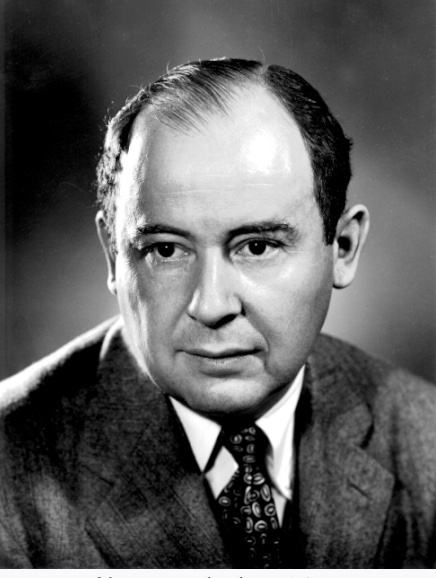
John von Neumann was born on December 28, 1903, in Budapest, Hungary. John (baptized as János) was readily recognized as a child prodigy, possessing an eidetic memory and at age 6 displayed the ability to divide two eight-digit numbers in his head. His family often entertained guests with demonstrations of his prodigious memory. The guests would randomly select a page from a telephone book for John to scan, and when he had committed a column of names and numbers to memory they would quiz him, and be astounded by his accurate recall. Throughout his life, John was able to recite verbatim pages of classical literature in Ancient Greek.
In 1911, at the age of 7 John entered the Lutheran Gymnasium, a prestigious school, where John’s prodigy was immediately recognized. He was given a special tutor and by age 8, he had become proficient in calculus. He graduated in 1921 and enrolled in chemistry at the University of Berlin. His interest in mathematics eventually resulted in his writing a dissertation on set theory for which he was awarded a Ph.D. from the University of Budapest at the age of 22. In 1928, he published his seminal paper The Axiomatization of Set Theory, and was one of the first to perceive the importance of Gödel’s completeness theorems.
During the next decade, von Neumann continued to lecture in mathematics in Germany, and between 1930 and 1933 at Princeton in mathematics and quantum physics. In 1933, he became one of the original six members of the newly-created Institute for Advanced Study at Princeton where he would work for the remainder of his life.
In 1944, John von Neumann and Oskar Morgenstern published their groundbreaking Theory of Games and Economic Behavior in which they sought to mathematize strategic decision–making. By listing the options available to two adversaries and exploring the payoffs and penalties of each option, they sought to find an optimal solution for each combatant. As one of the fathers of the computer, von Neumann may have been anticipating a future use of computer-based decision–making. Human judgements in the decision-making process would be replaced by algorithmic procedures that would yield optimal results the way today’s computer chess programs scan the available options and choose the most promising move. What emerged from this publication was an entirely new branch of economics that is known today as game theory. Coincidentally, in fewer than ten years after its creation, this theory would be tested on the world stage in a dramatic political struggle that would threaten the existence of the human species, and be remembered as the most important period of decision making in human history–the Cuban missile Crisis.
Near the end of the War, John von Neumann, while working on the Manhattan Project, modified the ENIAC computer to make it programmable. Robert Oppenheimer, the Director of the Project, had engaged von Neumann to calculate the height at which the atomic bomb should be detonated to exact maximum damage. Time was tight and the race to develop the bomb was heating up. “Johnny,” as he was addressed by his friends and colleagues, was revered for his brilliant computing power, and had done the calculations by hand, arguing that the Project could not afford to wait a week or two for the computer to verify his calculations. However, Oppenheimer overruled him, and everyone waited impatiently as the computer chugged through the extensive calculations. It was the middle of the night when the computer yielded its final output. The excited scientists waited until after 10:00 a.m. to telephone von Neumann, to share the good news, because everyone knew that von Neumann was a late sleeper. The conversation is reported to have unfolded something like this:
Von Neumann (sleepily answering the telephone): Johnny here.
Scientist: Dr. von Neumann, the computer has finished its calculations and they verify that your computations are correct!
Von Neumann: You wake me up early in the morning to tell me that I’m right? Please don’t call me when I’m right; call me when I’m wrong! (and hangs up!)
After the War, von Neumann returned to the Institute for Advanced Study in Princeton. Expanding on some of Turing’s ideas, he constructed a more powerful computer named IAS (acronym for the Institute for Advanced Study). The IAS computer was much more compact than the ENIAC and used only 1700 vacuum tubes.
John von Neumann died of cancer at the age of 53, possibly from his over exposure to radiation experienced during his work on the testing of atomic bomb. In spite of his genius for mathematics, he acknowledged that deductive thinking is slow and arduous, and once confessed to a struggling student,, “Young man, in mathematics you don’t understand things. You just get used to them.”
